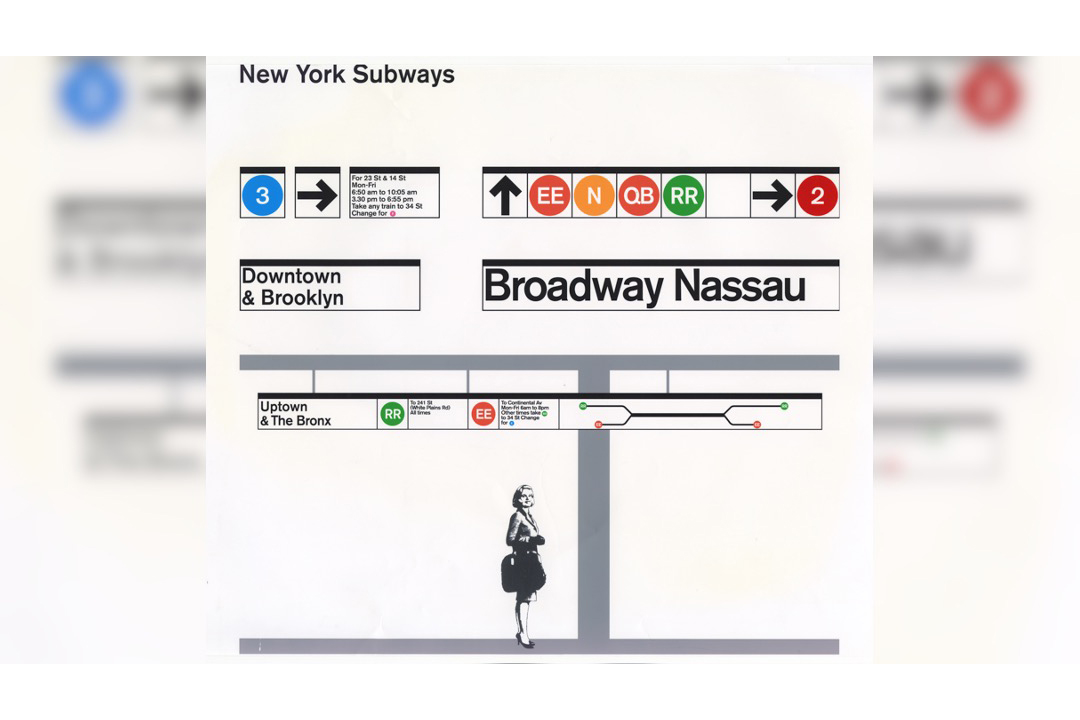Vignelli Center launches digital archives
Massimo Vignelli and Bob Noorda designed the signage and maps for the New York City Subway system.
The goldmine of rare design gems that resides in RIT’s Vignelli Center for Design Studies is now widely available with the recent launch of its digital archives.
The Vignelli Center joined Google Arts & Culture as a partner last month to share its archives in a virtual space. Users can browse nearly 900 high-resolution images of artifacts (and counting) from the Vignelli Center archives — which holds the work of more than 40 eminent designers, including Massimo and Lella Vignelli.
“The number of untold stories in the archives are endless,” said Jennifer Whitlock, the Vignelli Center archivist who spearheaded the center’s Google Arts & Culture project and its digitization efforts. “I am very excited that I now have a platform to share the collections and their stories.”
Access to the online archives, and the bountiful design history embedded in them, is free and open to all.
"Dream come true," artist Sheila Hicks commented on Facebook.
Google Arts & Culture is an online platform featuring content from more than 2,000 leading museums and archives. According to site analytics, 537 users from 52 countries visited the Vignelli Center’s Google Arts & Culture page 2,176 times during the first two weeks.
“Not only is it a nice tool — it looks great and has a lot of functionality — but it puts the Vignelli Center in the mix with these international institutions,” Whitlock said.

With the center housing an estimated 500,000 artifacts, many more objects and features will be regularly added to its Google Arts & Culture page. Visitors can search individual artifacts, sort them by color, view them on a timeline and explore stories and characteristics of the designs.
“The digital archives are a huge contribution to the history of design and an excellent resource for research, education and inspiration,” said Greg D’Onofrio, who runs the Display graphic design collection. He is also the co-author of The Moderns: Midcentury American Graphic Design, which features some designs from the Vignelli Center archives. “The website makes it quick and easy to explore and is a terrific substitute if you can't access the physical archive. I’m particularly interested in uncovering new connections using the ‘organize by time’ feature which will become more valuable as the remaining 499,100 artifacts are added.”

The open digital access only adds to the existing value the Vignelli Center provides RIT students, staff and faculty, as well as professionals around the globe. Whitlock said the online resource facilitates easier exploration of archived material in the Vignelli Center.
“The more I can share, it helps people understand what’s in the archives,” Whitlock said. “It helps them understand what we’re doing here.”
"Because of the accessibility of the Google Arts & Culture platform, the educational possibilities this opens for the Vignelli Center are expansive," said Josh Owen, Vignelli Center director and the Massimo and Lella Vignelli Distinguished Professor of Design. "With our mission intrinsically linked to design-education, the impact this development creates is very exciting. The Google Arts & Culture page is a contemporary tool added to our kit for all who seek a digital point of entry into the lessons the Vignellis left for us to share."
Since its opening on RIT’s campus in 2010, the Vignelli Center has attracted designers and scholars from around the world to its archives. Especially during COVID-19, the new online database is greatly expanding archive access. It’s also streamlining the ways classes at RIT use the archives for creative inspiration and research.
“It’s exciting and satisfying to finally see this become reality,” Whitlock said. “Particularly at this moment, because we’re doing so much virtually, it makes a big difference for the classes that interact with the archives to have this database to search.”
In addition to the Google Arts & Culture page showcasing different Vignelli Center collections, it also holds online exhibitions, labeled “stories.” The current highlighted exhibitions are based on the Vignelli Center’s two floors of galleries, curated by Massimo and Lella Vignelli themselves. The galleries mirror the famous “Design:Vignelli” exhibition of Massimo and Lella’s work that toured nine countries from 1989-93.
Whitlock’s photo documentation of the physical galleries is digitally preserving the iconic showcase.
“As with the previous touring exhibition, Lella and Massimo designed the displays, wrote the descriptive text and curated the artifacts for our galleries,” Whitlock said. “They also designed all the artifacts on view in the exhibition and even the Vignelli Center building itself. This extraordinary Vignelli experience has been reproduced virtually.”

Whitlock’s intensive digitization work started the day she became the Vignelli Center archivist in 2013. Since, she’s created countless high-resolution assets using a large flatbed scanner and collaborating with Elizabeth Lamark, university photographer, and utilizing RIT Libraries resources. Each digitized object is accompanied by text communicating contextual information and properties of the design.
Trista Finch '20 (Graphic Design), who is pursuing an MS in Human-Computer Interaction from RIT's Golisano College of Computing and Information Sciences, has had the luxury of the center's archives being at her fingertips. Now, she's thrilled for a wider audience to engage in similarly enriching experiences.
"The Vignelli Center is one of the best design resources in the country," said Finch, who uses artifacts from the archives for class and personal projects and serves on the Vignelli Council. "It makes me so excited that our resources will be able to be easily accessed all around the world on such a well-known and established stage. One of the ways the Vignelli Center continues to stay relevant and prominent is by finding new ways to share the artifacts that have been donated by the Vignellis and other designers."













